
My cup runneth over...
May 19th, 2010
...with CUTE BABY GOSLINGS!
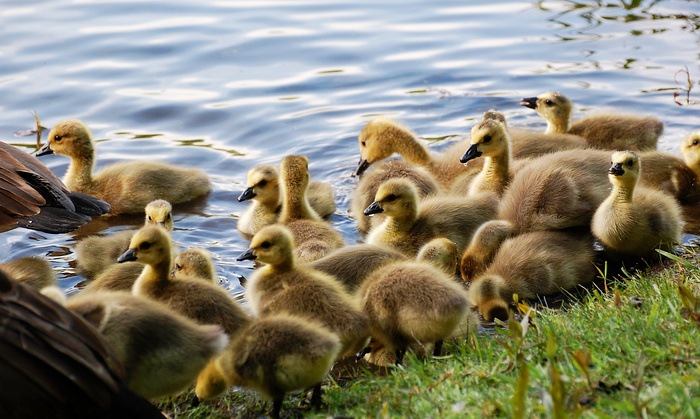
1680x1050 wallpaper
All the Canada Geese parents at Mud Lake have hatched their young and formed a creche in the usual place, along the north shore.
Point Pelee Part 2: The People
May 18th, 2010
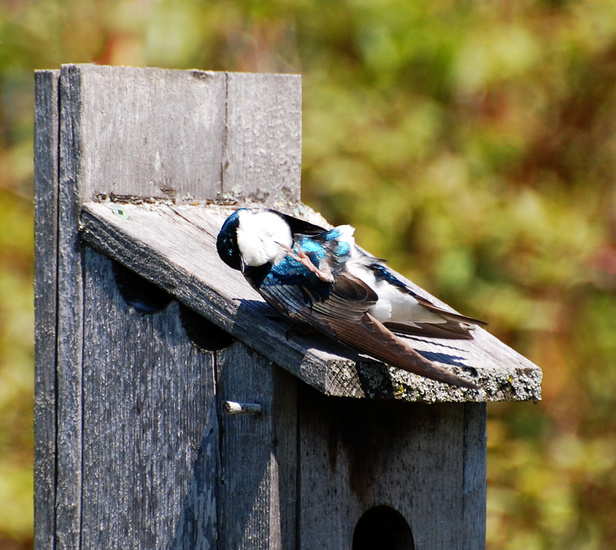
Tree Swallow on a nest box at Thickson Woods. Itchy scratchy!
First, all about our two leaders: Roy and Ken.
Roy was sort of a drill sergeant for a good cause. He's the fellow who said, "the bus will leave at oh five four five point zero zero zero" and "rule number one: do not stand in the door of the bus. There are almost forty people on the bus and none of them can get off if you stand in the door. Rule number two: do not stand in the door of the bus. Rule number three: if you stand in the door of the bus, I will push you out."
Helpful, knowledgeable, and dedicated. An absolute ace at bird ID, even when all he got was a glimpse. As for his stickler rules, they were all for our sake--to insure that everyone had a great time, that no one person's carelessness sabotaged other people's enjoyment.
Ken was the type B to Roy's type A. The good cop to Roy's bad cop. The guy who exuded good humor and patience and generally had fun with it. The guy who said, after I and another woman arrived on the swamp boardwalk about fifteen minutes later than the rest of the group, all of us searching for the beautiful nesting Prothonotary Warbler, "you missed it." And then waited just a few moments for that to sink in before breaking into a grin and adding, "so did we."
Equally helpful, knowledgeable, and dedicated. Obviously an experienced naturalist, maybe a career naturalist. Always trying hard to maximize everyone's experience. After a bunch of us had been watching some interesting bird for a period of time, and we were about to move on, he'd ask a question like, "has anyone still not seen the [species name] who wants to?" And if someone said yes, he'd maneuver them into position, point, and give treasure-map-esque directions ("okay, see that fork in the big pine tree?") to the bird.
In case you can't tell, I really liked both of the leaders: they were an excellent team and the way their personalities played off each other was a source of amusement, at least to me.
I also overwhelmingly liked the group as a whole, and made all sorts of connections with all sorts of people. I constantly seemed to be ending up in mingle circles, chatting freely about various birdy things. Yes, really. Me, in mingle circles! The strong common interest, I guess, is what made it happen. It just came naturally.
There was a rather thrilling moment, socially, on the bus going home, when Ken stood up at the front and we all helped put together the communal trip list. He listed off all the species of birds in all the various categories (herons, warblers, sparrows, etc.) that he knew of that we had seen, and for each category, if someone had seen a bird in that category that wasn't listed, they spoke up. He sometimes mentioned likely omissions, e.g. "has anyone actually seen a Wood Thrush?" (Answer: no. We heard plenty, spotted none. Typical!)
It was thrilling because all that systematic, geeky, science-y stuff that I've always done privately--making trip lists, marking which birds I actually spotted and which I only heard, etc.--was now being done as a group. (Although, of course, I also maintained my private list which I will share with you in due time.) And they were as keen to get it down and get it right as I was. It was a thrilling sense of belonging, of having found a community.
I've been to a few other OFNC events, but none that worked nearly as well, socially, as this one. Now I want more. Now I want to spend more time with these people. Go on more events. Maybe even go to the monthly meetings.
Point Pelee Part 1: The Bus Trip From Hell
May 17th, 2010

Male Red-Winged Blackbird photographed at the Thickson Woods marsh. Also, what my mood looked like around midday Thursday.
I'd call the trip to Leamington a "comedy of errors" except that there was nothing funny about it. It started in the parking lot of Lincoln Fields. Our driver discovered a problem with the brakes on the bus. It was a dangerous enough problem that we couldn't leave without getting it fixed. We ended up waiting over an hour before the replacement bus got there.
Then, some hours out of Ottawa, the air conditioning broke down. And the driver refused to go on without it. I didn't think the temperature was that bad--it was mid-May, after all, not mid-July--but apparently at least a few people did and the matter was not put to a vote. The replacement bus had to come all the way down from Gatineau; as you can imagine, that took awhile. In fact if I remember correctly it was something like five more hours before we finally boarded bus number three.
The good news is, our excellent leaders came up with an excellent "plan B": while we were waiting for the second replacement bus, instead of standing around in a parking lot, we would go to nearby Oshawa Marsh and bird it. We had a fine time there and some good birding, including my first two lifers of the trip: House Wren and Trumpeter Swan. Then, when the replacement bus still hadn't arrived, we stopped next to several fast food restaurants and had dinner.
We finally made it to the hotel, tired and bedraggled, around 10:45 pm. And I promptly turned in for a 4:15am wake up the next morning. As is my wont anytime I'm spending the night in a new location, I got not a single wink of sleep. (Didn't help that something in the sheets gave me an allergic reaction.) Add to this the fact that the night before, at home, was also virtually sleepless, and that was some pretty impressive sleep dep I racked up. I had serious doubts as to how well I would be functioning on this trip and particularly on the next day.
As it turns out I did just fine, more than fine, I did great. Throughout Friday, on zero sleep, I burned my candle at both ends--not merely a solid morning of birding, not merely a solid morning and solid afternoon of birding, but a morning, afternoon, AND early evening of birding! About twelve hours all in all, twelve hours with breaks but still twelve hours. By the end of it, a double whopper and onion rings were only just enough to fill the hole in my stomach. I think I got to the point where I was substituting food for sleep.
The following two nights I slept well. I never even began to make up for the sleep dep, yet I thrived in spite of it (except for a lingering bronchitis, which came back on me with a vengeance during this trip.) And there were no more snafus, for the rest of the trip.
A quick shout out from a public terminal
May 15th, 2010
Day 1 of the Point Pelee trip: "Comedy of errors" does not even begin to cover it. The bus was schedule to leave at 6:00am. The trip was to be about 8 hours, plus about 2 additional hours of birding en route at Hillman Marsh. We checked into the hotel at 10:45pm. You do the math.
Seriously, we're famous here now. We run into random people on the trails and they're all "oh, you're the Ottawa group. We heard about that."
Day 2: Point Pelee is unbelievable. Incredible. Astounding. Awe-inspiring. And many other adjectives. In one morning + afternoon, I racked up five lifers and a downright dizzying full species list that included something on the order of twenty different warblers. (It was an incredible place for other reasons too, which I'll describe in a later, much more detailed post.) I will go back someday. Oh god, so help me, I WILL go back someday.
Day 3 (today): Rondeau Provincial Park was nice, but does not deserve to be mentioned in the same sentence or even the same paragraph as Point Pelee. Unfortunately, not knowing that, I took the camera out today instead of yesterday. Still got a few good pictures though.
Day 4: The trip home with a birding stop at Thickson Woods. I plan to be camera-enabled, if weather permits. Wish me (and all of us) luck that the trip home will not be as much of an "adventure" as the trip here.
Mud Lake, May 10th
May 12th, 2010
As the early nesters bear, raise, and even fledge their young, other species are only just beginning. The next big wave of spring migration has hit.
Baltimore Orioles are back--three flame orange males at various locations around Mud Lake, all of them camera shy. American Redstarts are back and singing. Cedar Waxwings have returned from wherever they wandered to last winter (it's variable), and are now present in flocks throughout the BCA. Catbird songs emanate from every other bushy thicket. And Warbling Vireos and Yellow Warblers are singing their little hearts out.
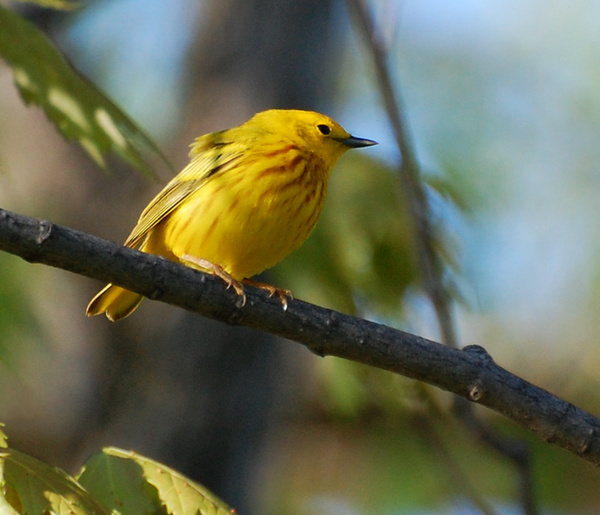
1680x1050 wallpaper
On Tuesday afternoon, insect swarms by the Ottawa River attracted an impressive mixed flock of literally hundreds of swallows and swifts, whizzing through the air at high speed as they snapped up whatever they could. I love swallow-watching, though I don't usually attempt it with a camera--they just move too fast. I guess I was a glutton for punishment that day, because I tried it anyhow. I was rewarded with a surprisingly well-focused shot of a Chimney Swift.
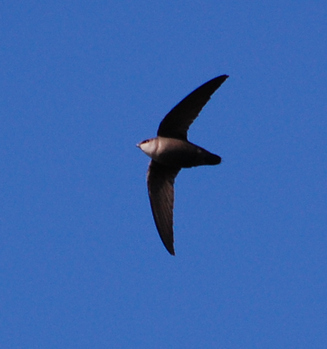
Swifts are the most aerial class of birds in the world--and Chimney Swifts are no exception. Unless they have young to tend, they spend literally the entire day in the air. They are incapable of perching. They're common birds, but unless you find a nest/roost site inside a chimney or hollow tree (where they cling to vertical surfaces), the only way you'll ever see them is in flight. Swifts remind me of bats--their strange nesting habits, their irregular, fluttery flight--but they're birds, most closely related to the hummingbird family.
Trivia point: authentic Bird's Nest Soup is made from the saliva of Cave Swiftlets. As if they weren't batlike enough, some cave swifts use echolocation to find their nests in the dark.
All three of Mud Lake's breeding herons (Great Blue, Green, Black-Crowned Night) are back on territory. Great Blues have been back for awhile, but this one on Tuesday was my first of the year.
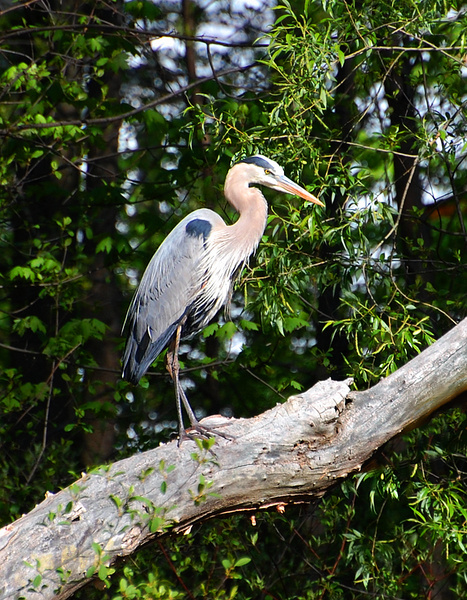
I've seen little variety of migrant warblers so far this year--haven't been out at the right times and places, I guess. That's fine, since tomorrow I'm off to Point Pelee, migrant warbler capital of the world!
A Time For New Life
May 11th, 2010
Yesterday at Mud Lake, something I'd never witnessed before: Red-Winged Blackbirds mating! In my years as a birder it's one of the most charming things I've ever seen.
( Cut for the bashful )
For others, there's already new life.

Specifically, two very yellow, very fluffy, and very newborn Canada Goose goslings. I don't know if they've even been in the water yet--that bit of wetness on his down may be from hatching. The parents are still very protective, hissing if I get too close. (Later on, they'll warm to humans again and even teach their young how to solicit handouts.)
Elsewhere around Mud Lake, patient mothers continue to brood. Once all the goslings are hatched, the parents will gather them together into a creche for communal protection.
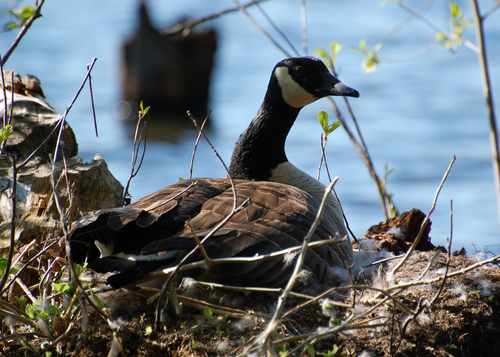
A very few are further along still. Ravens lay their eggs as early as February. The raven's nest at Mud Lake already has fledged young. The teenage ravens are flying around in the canopy near the nest, calling back and forth to each other and generally making an ungodly racket any time of day.


South-of-the-airport birds
May 5th, 2010
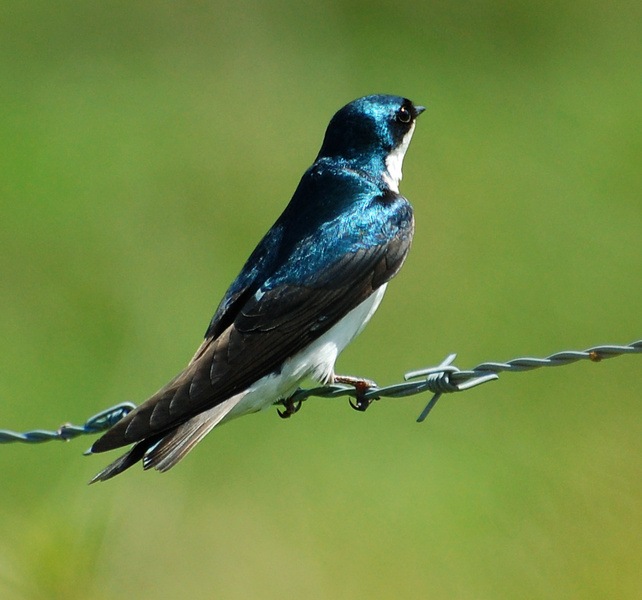
Tree Swallow, wallpaper available
I heard far more than I saw, south of the airport today--and saw far more than I photographed. The birds were active but elusive.
As were the butterflies. They're out in good numbers now--Spring Azures, migrant Red Admirals, plus, a new one for my unofficial "butterfly lifelist": a Black Swallowtail. None of them would stay still for a picture.
Though it was afternoon, not morning, there was lots of birdsong. Field, Vesper, Savannah, Song, Chipping and White-Throated Sparrows all going at it, plus a Warbling Vireo or two--a recent arrival in Ottawa as of the past week. A Brown Thrasher joined the chorus as evening moved in.
Emanating from a fenced-off field, I could hear the sweet, plaintive song of an Eastern Meadowlark. It was almost enough to tempt me past the fence--meadowlarks are as beautiful as their voices are sweet--but there are signs posted, and I don't know if they're "no trespassing unless you mean well" signs or "NO TRESPASSING" signs, so I didn't. I also saw and heard a Bobolink in his ecstatic flight display, which marks my first Ottawa sighting of that species, and glimpsed a Northern Harrier, both in the same fenced-off field.
The one species that was available for as many photographs as I cared to take was Tree Swallows. Oh my goodness, the Tree Swallows. Tree Swallows left, right and center. Tree Swallows in the air, in the fields, on the lines, and on the nest boxes. And they look like they have every intention of taking over as many of those boxes as they can.
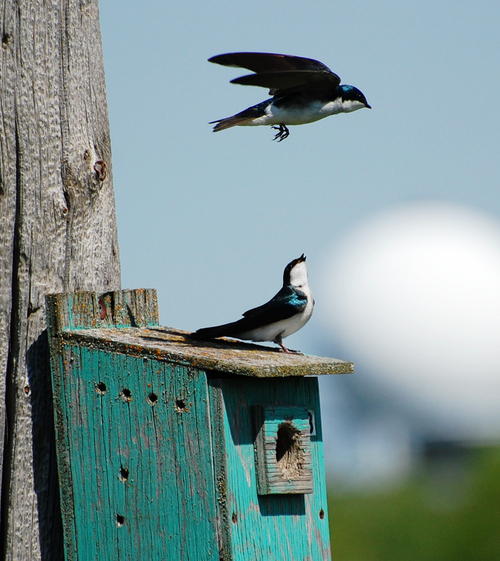
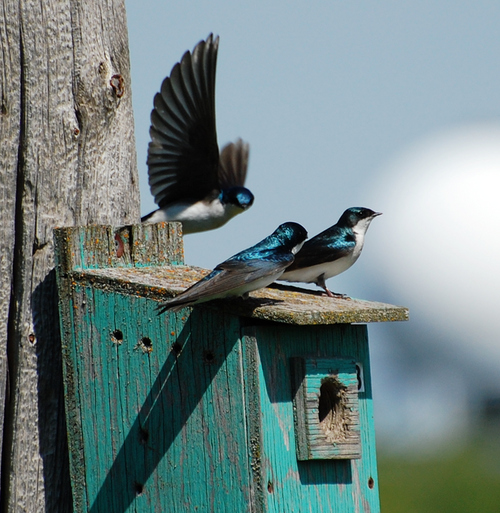
There was much squabbling. "My nest!" "No, my nest!" "Oh yeah?!" Um, guys? These boxes were intended for bluebirds. And while you are, technically, blue birds, I'm pretty sure that's not what was meant.
As for the actual bluebirds, they were around, although not nearly as numerous nor as noisy as the swallows, nor were they showing any interest in the nest boxes. Perhaps there are boxes elsewhere that they favor. Must do more exploring.
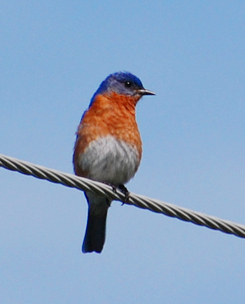
( More )
Where's Waldo?
April 29th, 2010
A treat at Mer Bleue this afternoon:

Actually, Waldo's not so hard to find in this picture. But when I first saw him, with naked eye, he looked only like a cattail that was a little darker, and leaning a little more to the right than the others. I twigged to it only because I'd been expecting it. I'd been listening to him call for the last half hour!
This is an American Bittern, a shy, stealthy and well-camouflaged marsh heron. American Bitterns are so shy that, if startled, they usually won't flush. Instead they'll stand erect with their bill straight up and sway in the breeze to imitate a cluster of reeds. Only my second sighting ever of this species and my first opportunity to photograph one, so it was pretty exciting.
Click on the link above to hear this bird's very unusual "water pump" mating call.

Recent Arrivals At Mud Lake
April 25th, 2010
To me, Northern Flickers are the most beautiful of all Ottawa woodpeckers, beating out even the magnificent Pileated and the rare Red-Headed. They're also one of our few migrant (rather than year-round) woodpeckers. They're quite skittish--it's not often I get a close-up like this one!
I only regret the bird's undertail is in shadow. It's actually a strikingly vivid yellow, as are the undersides of his wings.

( More )
Spring Springs
April 19th, 2010
A wonderful morning in the southern corridor today. (I think I'll call it by its old name, "The Uplands"--less of a mouthful.) Four "welcome back"s to returning spring migrants, and more interesting things besides. Its so nice to have buds opening now. I was getting tired of all my bokehs coming out blue or gray!

1680x1050 wallpaper
This Blue Jay was gathering nest material at the edge of the woods.
"Welcome back" number one is for Brown Thrashers. One of the first things I heard when I walked into the meadow was their familiar doubled-phrase song. There were at least two singing males on territory. This is the best and frequently only time to see Brown Thrashers--when they're not singing, they're usually skulking in the bushes unnoticed.

Number two, this bashful Savannah Sparrow.
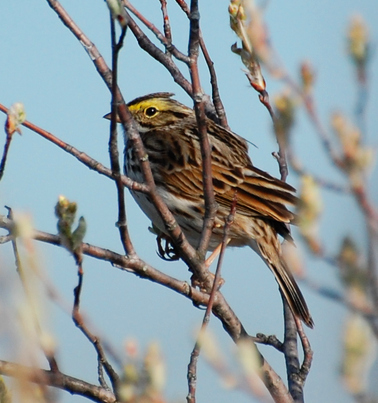
He didn't really want to be seen, but you can only hide so well when the leaves on the bush are just budding.
Numbers three and four have a story behind them.
At Gaspe, there was this bird song I heard. I heard it practically everywhere we went--anywhere with deep woods. I heard it in the mountains, on Bonaventure Island, at Forillon Park. It was a long, loud, ringing, exuberant song that seemed to echo through the treetops. It was a song that went on and on and on, three or even more trills connected by passages of chirpy up-and-down notes.
I tried and tried and never once managed to spot the bird. I went home and looked up bird songs left and right--any that seemed even remotely likely, Pine Grosbeak, both Crossbills, Fox Sparrow--nothing matched. Mostly, I looked up medium and large-size songbirds, not little ones. It never occurred to me that a little bird might make a sound like that.
Then I spent a weekend at a friend's cottage. And I heard the same song. And I went home and researched and still couldn't figure it out.
This morning, I heard that song again.
Well, you better believe I wasn't going to let that opportunity pass me by. For at least the next hour I searched for that bird. I bushwacked my way into the thick, wet woods across the train tracks, where the song was coming from--in the process, soaking my shoes right through to the skin. (Note to self: next time, wear hiking boots.) Whenever he stopped singing, I turned my attention elsewhere--for instance, to the pair of Hermit Thrushes, new arrival #3, who were in those same woods.
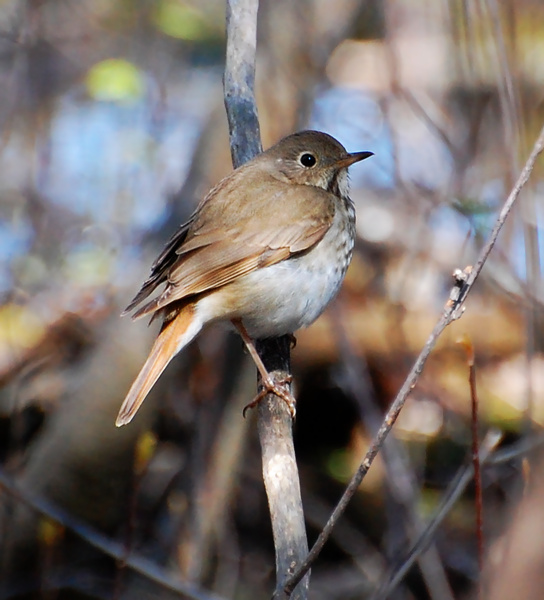
But I always had one dedicated ear listening for my mystery bird. Finally, I came to a spot in the woods and he sang and it was practically earsplitting, he was so close. I looked up. A tiny little bird came into view on top of a dead tree.
"Oh, no way," I thought. "Give me a break. The song merely led me to the little bird, the way it led me to those thrushes. It could not possibly be coming from the little bird."
The little bird was a Winter Wren. And yes, he WAS the producer of that song! I...had no idea. Most of the other wrens have reedy little gurgling songs and I just assumed Winter Wren followed suit.
Says AllAboutBirds: "Per unit weight, the Winter Wren delivers its song with 10 times more power than a crowing rooster."
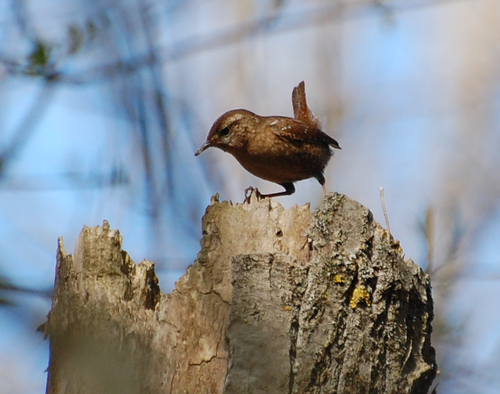
Isn't it wonderful that after years of this hobby, there can still be surprises?
|
